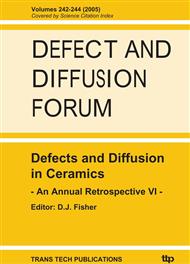[1]
L.V. Woodcock, C.A. Angell and P. Cheeseman, J. Chem. Phys. 65, 1565 (1976).
Google Scholar
[2]
Liping Huang, L. Duffrene and J. Kieffer, J. Non-Cryst. Solids 349, 1 (2004).
Google Scholar
[3]
K. Vollmayr, W. Kob and K. Binder, Phys. Rev. B 54, 15808 (1996).
Google Scholar
[4]
N. Kuzuu, H. Yoshie, Y. Tamai and C. Wang, J. Non-Cryst. Solids 349, 319 (2004).
Google Scholar
[5]
S. Sen, R.L. Andrus, D.E. Baker and M. T. Murtagh, Phys. Rev. Lett. 93, 125902 (2004).
Google Scholar
[6]
C. Oligschleger, Phys. Rev. B 60, 3182 (1999).
Google Scholar
[7]
N.T. Huff, E. Demiralp, T. Cagin and W. A. Goddard III, J. Non-Cryst. Solids 253, 133 (1999).
Google Scholar
[8]
A. Takada, P. Richet, C.R.A. Catlow and G.D. Price, J. Non-Cryst. Solids 345 & 346, 224 (2004).
Google Scholar
[9]
D.K. Belashchenko, Russian Chem. Rev. 66, 733 (1997).
Google Scholar
[10]
T.F. Soules, J. Chem. Phys. 71, 4570 (1979).
Google Scholar
[11]
S. Tsuneyuki, M. Tsukada, H. Aoki and Y. Matsui, Phys. Rev. Lett. 61, 869 (1988).
Google Scholar
[12]
S. Tsuneyuki and Y. Matsui, Phys. Rev. Lett. 74, 3197 (1995).
Google Scholar
[13]
B.W.H. van Beest, G.L. Kramer, R.A. van Santen, Phys. Rev. Lett. 54, 1955 (1990).
Google Scholar
[14]
U. Tracht, M. Wilhelm, A. Heuer, H. Feng, K. Schmidt-Rohr and H.W. Spiess, Phys. Rev. Lett. 81, 2727 (1998).
DOI: 10.1103/physrevlett.81.2727
Google Scholar
[15]
S.A. Reinsberg, X.H. Qiu, M. Wilhelm, H.W. Spiess and M.D. Ediger, J. Chem. Phys. 114, 7299 (2001).
Google Scholar
[16]
X.H. Qiu and M.D. Ediger, J. Chem. Phys. B 107, 459 (2003).
Google Scholar
[17]
G. Adam and J.H. Gibbs, J. Chem. Phys. 43, 139 (1965).
Google Scholar
[18]
J.P. Garrahan and D. Chandler, Phys. Rev. Lett. 89, 035704 (2002).
Google Scholar
[19]
J.P. Garrahan and D. Chandler, Proc. Nat. Acad. Soc. 100, 9710 (2003).
Google Scholar
[20]
W. Kob, C. Donati, S.J. Plimpton, P.H. Poole, and S.C. Glotzer, Phys. Rev. Lett. 79, 2827 (1997).
DOI: 10.1103/physrevlett.79.2827
Google Scholar
[21]
C. Donati, S.C. Glotzer, P.H. Poole, W. Kob, and S.J. Plimpton, Phys. Rev. E 60, 3107 (1999).
Google Scholar
[22]
K. Vollmayr-Lee, W. Kob, K. Binder, and A. Zippelius, J. Chem. Phys. 116, 5158 (2002).
DOI: 10.1063/1.1453962
Google Scholar
[23]
B.V.R. Tata, P.S. Mohanty, and M.C. Valsakumar, Phys. Rev. Lett. 88, 018302 (2002).
Google Scholar
[24]
Vo Van Hoang, to be published elsewhere.
Google Scholar
[25]
M. Vogel and C. Glotzer, Spatially heterogeneous dynamics and dynamic facilitation in a model of viscous silica, cond-mat/0402427.
Google Scholar
[26]
M. Vogel and C. Glotzer, Temperature dependence of spatially heterogeneous dynamics in a model of viscous silica, cond-mat/0404733.
Google Scholar
[27]
L.I. Tatarinova, The structure of solid amorphous and liquid substances, Moscow, Nauka, (1983).
Google Scholar
[28]
R.L. Mozzi and B.E. Warren, J. Appl. Cryst. 2, 164 (1969); 3, 251 (1970).
Google Scholar
[29]
J. Horbach and W. Kob, Phys. Rev. B 60, 3169 (1999).
Google Scholar
[30]
R.F. Pettifer, R. Dupree, I. Farnan, and U. Sternberg, J. Non-Cryst. Solids 106, 408 (1988).
Google Scholar
[31]
Vo Van Hoang, D.K. Belashchenko and Vo Thi Mai Thuan, Physica B 348, 249 (2004).
Google Scholar
[32]
D.K. Belashchenko and O.I. Ostrovski, Inorganic Materials 40, 241 (2004).
Google Scholar
[33]
Vo Van Hoang and Suhk Kun Oh, Physica B 352, 342 (2004).
Google Scholar
[34]
J.C. Mikkelsen, Appl. Phys. Lett. 45, 1187 (1984).
Google Scholar
[35]
G. Brebec, R. Seguin, C. Sella, J. Bevenot, and J.C. Martin, Acta Metall. 28, 327 (1980).
DOI: 10.1016/0001-6160(80)90168-6
Google Scholar
[36]
K.U. Hess, D.B. Dingwell, and E. Rossler, Chem. Geol. 128, 155 (1996).
Google Scholar
[37]
W. Gotzer, in Liquids, Freezing and the Glass Transition, Edited by J.P. Hansen, D. Levesque and J. Zinn-Justin, Les Houches, Session LI, 1989 (North-Holland, Amsterdam, 1991).
Google Scholar
[38]
R. Bruckner, J. Non-Cryst. Solids 5, 123 (1970).
Google Scholar
[39]
J.P. Hansen and I.R. McDonald, Theory of simple Liquids (Academic, London, 1986).
Google Scholar
[40]
A. Kerrache, V. Teboul, D. Guichaoua and A. Monteil, J. Non-Cryst. Solids 322, 41 (2003).
DOI: 10.1016/s0022-3093(03)00170-4
Google Scholar
[41]
It must be taken the exact percentage of particles detected from a tail of more mobile ones in the atomic displacement distribution, which is commonly equal to 5%. However, all results presented in the text are qualitatively the same if the 5% are replaced by 10%, but 10% include enough particles to obtain good statistics when examining their spatial correlation.
Google Scholar


